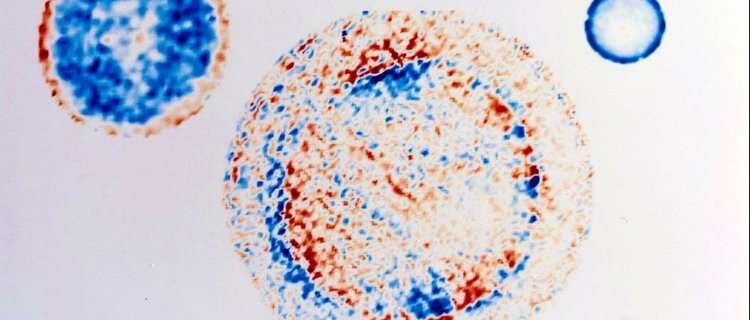How to get rid of the coffee-stain effect

The coffee-stain effect is a well-known effect in physics and daily life in which a dark-colored edge remains when a fluid containing particles evaporates. This is caused by an "avalanche" of particles moving to the outer edge, University of Twente scientists showed in a past study. In inkjet and 3-D printing, this is an undesired effect. Now, researchers have demonstrated that the effect can be suppressed by modifying the surface using an oily layer, according to results published in the Proceedings of the National Academy of Sciences (PNAS).
Earlier work of the UT research group showed that if a particle-laden droplet evaporates, the particles start moving to the edge of the droplet. At first, this is a slow and regular movement, but as soon as the droplet loses height by evaporation, the particles rush to the edge in a disorderly fashion, like in an avalanche. After full evaporation of the liquid, a dark ring remains. In fact, the diameter of the droplet dictates this process very early. The researchers sought to prevent this, because in many cases, a homogeneous distribution is required without a ring-shaped dark area. An oil-wetted surface is the answer, the new results show.
In this case as well, the droplet has an edge, but it is limited by a layer of oil that does not evaporate. It also prevents the water at the droplet's edge from evaporating quickly This in turn prevents particles from moving to the edge. They even move the other way, from the edge to the inside of the droplet. Once all water is evaporated, the particles uniformly cover the surface instead of forming a ring. The researchers also saw another effect: the oily layer entirely covers the droplet. In that case, a concentration of particles forms, a so-called nano-eye or "coffee eye." This could be a desired effect for some applications, like nanoparticle assembly. By adding surfactant to the droplet, the final particle deposition can be manipulated from the concentrated coffee ring to a homogeneous distribution.
Disease transfer
The Physics of Fluids group has a long-term research relationship with printer manufacturer Océ, now called Canon Production Printing. This company adds a special layer to the substrate (like paper) before the printer applies droplets. The new research results are very valuable for improving the processes.The new insights and improved control are valuable for other applications, as well, like 3-D printing and surface patterning. Better insights in the way liquids evaporate on a surface may also provide more knowledge about the way viruses are transferred from one person to another.
The research was done in the Physics of Fluids group and the Max Planck Center for Complex Fluid Dynamics. A week before publication, the main author of the paper, Yaxing Li (Anhui 1991) successfully defended his Ph.D. thesis, "Evaporating multicomponent droplets."
More information: Yaxing Li et al. Evaporating droplets on oil-wetted surfaces: Suppression of the coffee-stain effect, Proceedings of the National Academy of Sciences (2020). DOI: 10.1073/pnas.2006153117
Journal information: Proceedings of the National Academy of Sciences
Provided by University of Twente





















